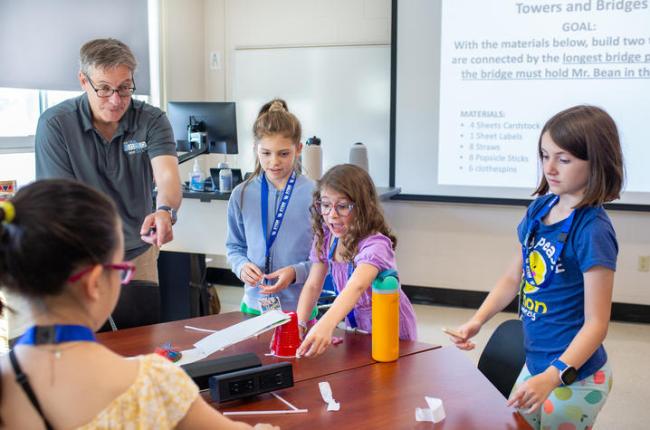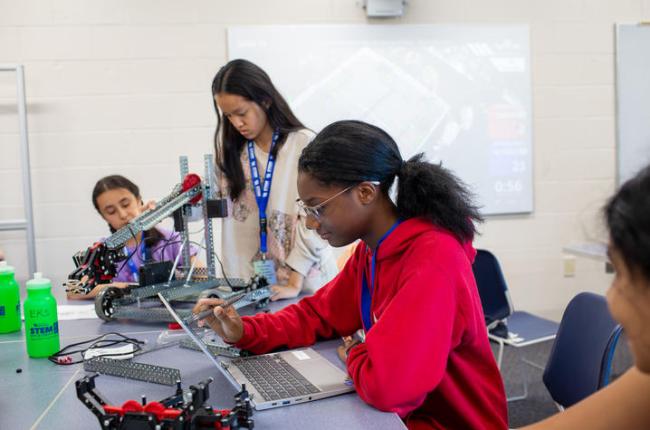UK STEM Experiences camps become gateway to rewarding opportunities for all
University of Kentucky Summer STEM Experiences Camps show what is possible when the university, local schools and community come together to bring STEM to life for youth.
“UK stands out as one of the rare universities in the country that combines a land-grant mission, a medical center and various academic departments all within one continuous campus. This unique setup offers an excellent environment to introduce campers to a wide range of specialty areas,” said Margaret Mohr-Schroeder, Ph.D., professor of STEM education, STEM Experiences Camps co-founder and UK College of Education senior associate dean for academic programs and partnerships.
For faculty members such as Clare Rittschof, Ph.D., STEM Experiences Camps are a chance to connect their work with the community and inspire the next generation. Showing campers career possibilities in agricultural STEM fields was a goal for Rittschof, associate professor of entomology in the UK Martin-Gatton College of Agriculture, Food and Environment. Campers went into the field with Rittschof to hear about her work with bees, supported by a $1.1 million National Science Foundation grant.
High school campers gained access to local industries and companies during the Go! Start! STEM! portion of camp, supported by the START Program with funding from the National Institutes of Health, exploring a variety of career possibilities. Whiting-Turner Construction hosted them for hands-on learning about construction at the Sanders-Brown Center on Aging research facility renovation.
For college students, the camps provided an opportunity to showcase their knowledge and share it with others. Some camp session leaders were UK College of Education students, including several majoring in Elementary Education and one in the Teacher Preparation Program in Visual Impairments. They gained student teaching days at camp.
“It’s a great opportunity. I’ve loved it,” said Abbi Stratton, who will return home to Graves County in Kentucky to teach fifth grade math this fall. “I’ve gotten experiences I wouldn’t get in a traditional classroom. It’s been a great way to prepare for the future, especially in STEM and hands-on learning. Something I’ve noticed is that when kids are able to touch and feel things, they feel much more connected to the content. It’s something they can relate to. You can see the lightbulb going on and they are very engaged the entire time.”
UK students on the Wildcat Robotics team, who recently competed at the Vex U Robotics World Championships and placed in the top 10 in their first showing, helped with the Vex Robotics section of STEM Experiences Camps, inspiring the next generation with their knowledge of coding, teamwork, and problem-solving. A postdoctoral scholar with the Kentucky Geological Survey used their work with unmanned aircraft system applications to spark interest in geology among campers attending drone camp.
Interacting with real-life scientific artifacts in the UK College of Medicine’s Donald T. Frazier Science Outreach Center, was a highlight for elementary and middle school students in STEM Camp.
The camps’ hands-on experiments and engaging activities are a collaboration among UK’s College of Education, Stanley and Karen Pigman College of Engineering, College of Arts and Sciences and College of Medicine. Teachers and support staff from Fayette County and other area schools help lead campers throughout the experience.
UK’s STEM Experiences Camps, which launched in 2010, have been replicated in seven states through partnerships with university faculty. Each has created their own version of what camp should look like based on the needs of schools and communities in their region. Together, faculty across the replication sites are studying the impact of STEM camps — such as whether camps help students gain increased interest and confidence in STEM and the camps’ effectiveness in recruiting teachers to the field.
For more information, visit education.uky.edu/stem/camp.
Research reported in this publication was supported by the National Science Foundation under Award Number 2045901. The opinions, findings and conclusions or recommendations expressed are those of the author(s) and do not necessarily reflect the views of the National Science Foundation.
This program was supported by the National Institute of General Medical Sciences of the National Institutes of Health under Award Number R25GM132961. The content is solely the responsibility of the authors and does not necessarily represent the official views of the National Institutes of Health.


